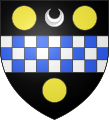Bezant


In theMiddle Ages,the termbezant(Old French:besant,fromLatinbizantius aureus) was used inWestern Europeto describe severalgold coinsof the east, all derived ultimately from theRomansolidus.The word itself comes from the GreekByzantion,the ancient name ofConstantinople,the capital of theByzantine Empire.
The original "bezants" were the gold coins produced by the government of theByzantine Empire,first thenomismaand from the 11th century thehyperpyron.Later, the term was used to cover thegold dinarsproduced by Islamic governments. In turn, the gold coins minted in theKingdom of JerusalemandCounty of Tripoliwere termed "Saracen bezants", since they were modelled on the gold dinar. A completely differentelectrumcoin based on Byzantinetracheawas minted in theKingdom of Cyprusand called the "white bezant".[1]
The termbezantin reference to coins is common in sources from the 10th through 13th centuries. Thereafter, it was mainly employed as amoney of accountand in literary and heraldic contexts.[2]
Medieval history
[edit]Gold coins were rarely minted in early medieval Western Europe, up until the later 13th century;silverandbronzewere the metals of choice for money. Gold coins were almost continually produced by the Byzantines and medieval Arabs. These circulated in Western European trade in smallish numbers, originating from the coinage mints of the Eastern Mediterranean. In Western Europe, the gold coins ofByzantine currencywere highly prized. These gold coins were commonly called bezants. The first "bezants" were the Byzantinesolidicoins; later, the name was applied to thehyperpyra,which replaced thesolidiin Constantinople in the late 11th century. The namehyperpyronwas used by the late medieval Greeks, while the name bezant was used by the late medieval Latin merchants for the same coin. The Italians also used the nameperperoorpiperofor the same coin (an abridgement of the namehyperpyron).
Medievally from the 12th century onward (if not earlier), the Western European term bezant also meant thegold dinarcoins minted by Islamic governments. The Islamic coins were originally modelled on the Byzantinesolidusduring the early years after the onset of Islam. The term bezant was used in the late medievalRepublic of Veniceto refer to the Egyptian gold dinar.Marco Poloused the term bezant in the account of his travels to East Asia when describing the currencies of theYuan Empirearound the year 1300.[3]An Italian merchant's handbook dated about 1340,Pratica della mercaturabyPegolotti,used the termbisantfor coins of North Africa (including Tunis and Tripoli), Cyprus, Armenia and Tabriz (in today's northwestern Iran), whereas it used the termperpero/piperofor the Byzantine bizant.[4]
Although the medieval "bezant" usually referred to a gold coin, some medieval Latin texts have been noted to expand its usage to cover silver coins. These silver bezants were often called "white bezants".[5]Occasionally in Latin they were also called "miliaresionbezants "/"miliarensebezants ". Like the gold bezants, the silver bezants by definition were issuances by the Byzantine government or by an Arabic government, and not by a Latin government, and the usage of the term was confined to the Latin West.
Bezants in heraldry
[edit]Inheraldry,aroundelof a gold colour is referred to as abezant,in reference to the coin. Like manyheraldic charges,thebezantoriginated during the crusading era, when Western European knights first came into contact with Byzantine gold coins, and were perhaps struck with their fine quality and purity. During theFourth Crusadethe city ofConstantinoplewas sackedby Western forces. During this sacking of the richest city of Europe, the goldbezantwould have been very much in evidence, many of the knights no doubt having helped themselves very liberally to the booty. This event took place at the very dawn of the widespread adoption of arms by the knightly class, and thus it may have been an obvious symbol for many returned crusaders to use in their new arms. When arms are strewn with bezants, the termbezantéeorbezantyis used.
-
Banner of theDuchy of Cornwalldisplaying fifteenbezants
-
Arms ofSir John Russell,a 13th-century English courtier.[6]
-
Arms ofWilliam Pitt the Younger
References
[edit]- ^Peter Edbury, "Ernoul, Eracles and the Beginnings of Frankish Rule in Cyprus, 1191–1232",Medieval Cyprus: A Place of Cultural Encounter(Waxmann, 2015), p. 44.
- ^Philip Grierson, "Bezant",The Oxford Dictionary of Byzantium(1991).
- ^Yule, Henry;Cordier, Henri.The Travels of Marco Polo: The Complete Yule-Cordier Edition.Third edition (1903), revised and updated by Henri Cordier. Plain Label Books. p. 1226-27. (ISBN1-60303-615-6)
- ^La Pratica della Mercatura,by Francesco Balducci Pegolotti, dated 1343, full text online in Italian atMedievalAcademy.org.
- ^Bezant@The Penny Cyclopaedia of the Society for the Diffusion of Useful Knowledge,Volume 4, year 1835.
- ^Arms of Russell ofKingston Russell&Dyrham.Sir John Russell was a favoured courtier of King Henry III, granted by the King the barony of Newmarch c. 1216.
External links
[edit]![]() Media related toBezantsat Wikimedia Commons
Media related toBezantsat Wikimedia Commons


![Arms of Sir John Russell, a 13th-century English courtier.[6]](https://upload.wikimedia.org/wikipedia/commons/thumb/6/6f/RussellofDyrhamArms.jpg/94px-RussellofDyrhamArms.jpg)
